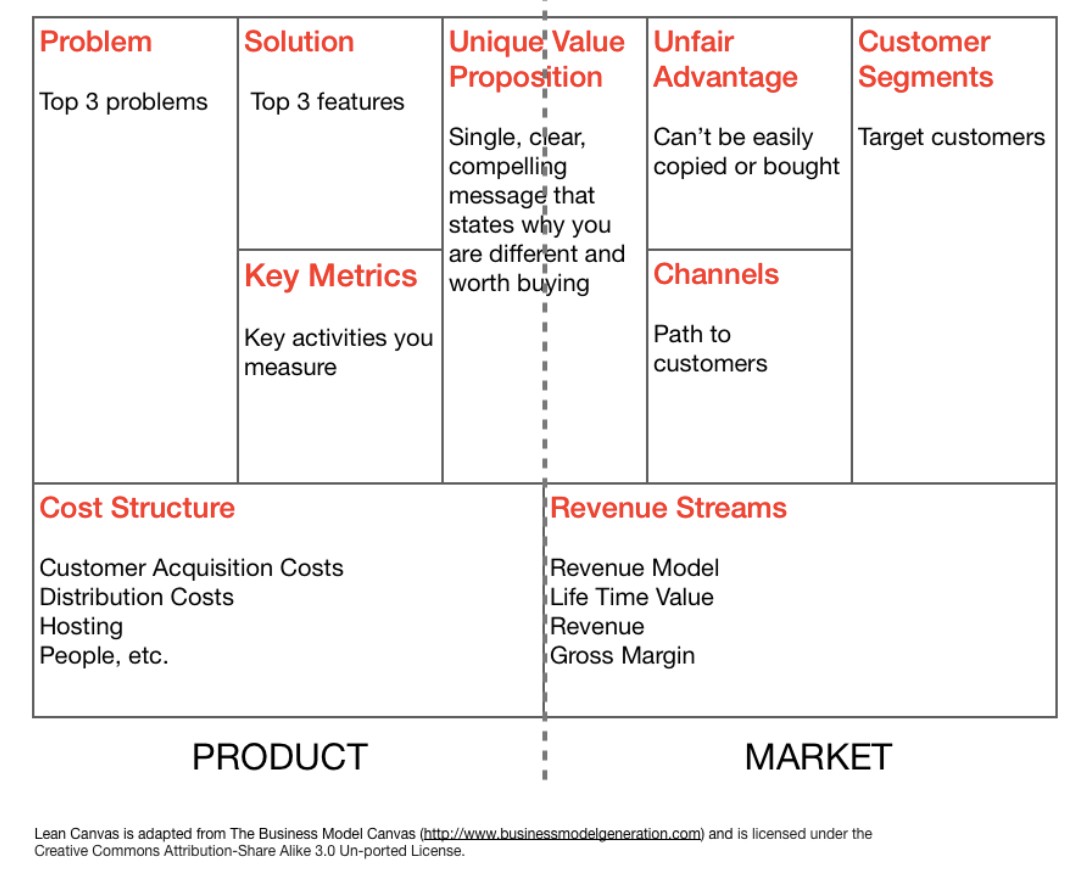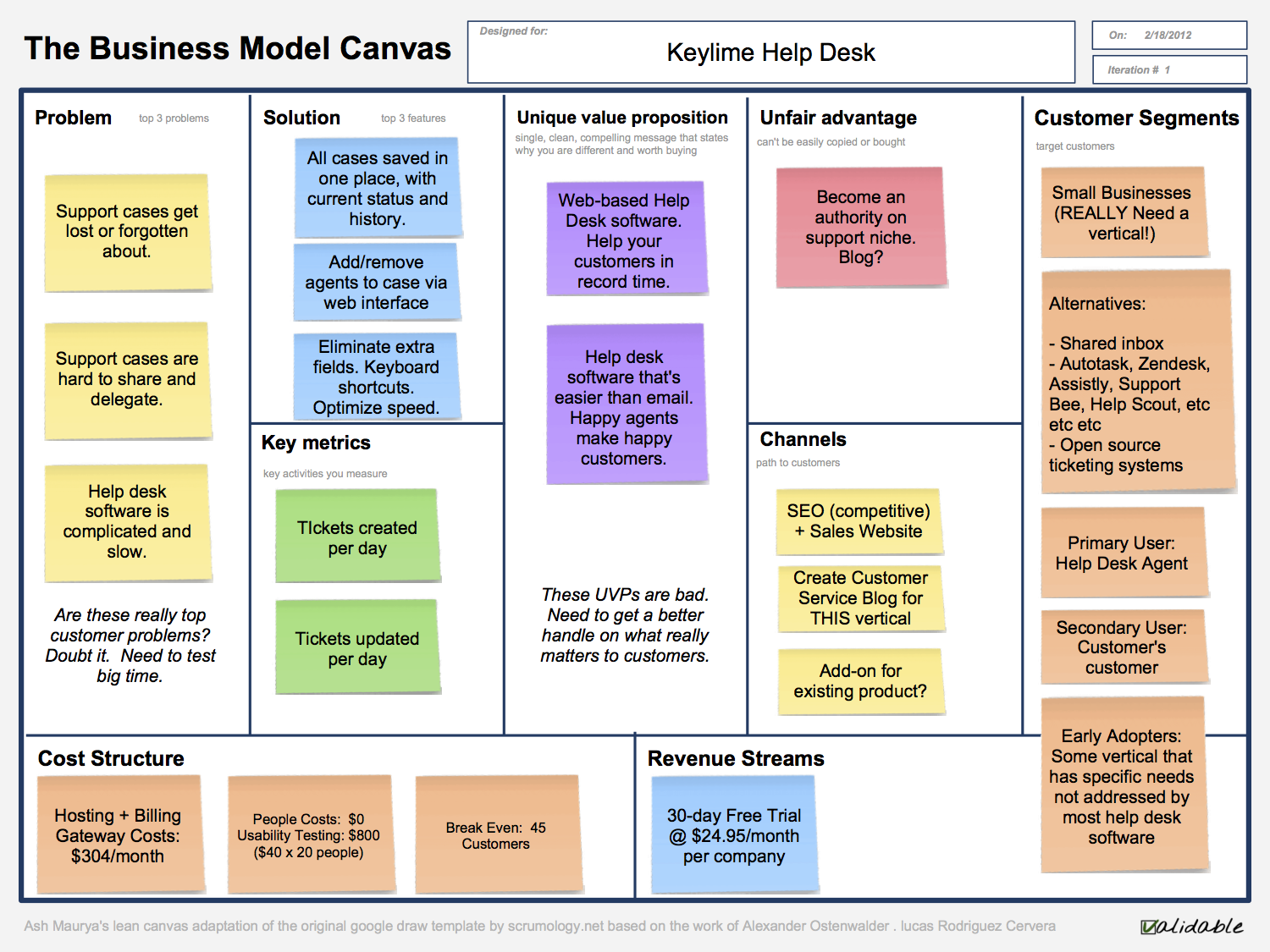As an entrepreneur, one of the most important tasks you can perform is getting your idea(s) out from your head into a tangible format so that you can communicate that with others. In the past, this usually meant a well-researched business plan, that would usually take weeks (more like months) to create.
I turn to the Lean Canvas to help me quickly formulate possible business models, product launches, campaigns and variations of, and communicate this with my stakeholders for my Lead Flow Method work. Having the Lean Canvas as a visual guide made this part ?communicating the model/idea? so much more effective ? and I think the most valuable function of the tool.
The problem with business plans for startups & entrepreneurs are that they?re a waste of time, don?t get me wrong a well-researched business plan is important but only at the right stage of your business (usually when you?re in growth/investment).
This quote from Steve Blank sums up this point in case: ?Business Plan: a document investors make you write, that they don?t read?.
The key fundamental to Lean methodology is the elimination of waste ? this includes time, processes, inventory and more.
So as a lean startup you need a quicker way to get ideas out of your head, you need to stay lean & avoid waste ? so, it?s time to introduce Lean Canvas.
Before we jump into the Lean Canvas it?s important to point out that Lean Canvas has been adapted by Ash Maurya from the very popular Business Model Canvas by Alexander Osterwalder ? check out this video for more information (40+ mins).
Lean Canvas uses the same 9 blocks concept except they?ve been modified slightly to suit the needs/ purposes/requirements of a Lean Startup. The Lean Canvas is the perfect one-page format for brainstorming possible business models, the blocks guide you through logical steps starting with your customer problems right through to your unfair advantage (often the hardest block to answer).
Blank Lean Canvas:
 Source: Running Lean
Source: Running Lean
Here is a quick explainer of each Lean Canvas block (and in the order to go through them):
1. Problem
Each customer segment (CS) you are thinking to work with will have a set of problems that they need solving. In this box try listing the one to three high priority problems that you CS has. Without a problem to solve, you don?t have a product/service to offer.
2. Customer Segments
The problem and Customer Segments can be viewed as intrinsically connected ? without a CS in mind you can?t think of their problems, and visa-versa.
3. Unique Value Proposition
In the middle of the canvas is the UVP. A value proposition is a promise of value to be delivered. It?s the primary reason a prospect should buy from you. A way to get your head around this is to think why are you different and why should your CS buy/invest time in you ? further reading: Useful Value Proposition Examples (and How to Create a Good One)
4. Solution
Finding a solution to the problem is the golden egg! You?re not going to get this right off the first bat ? it?s OK, as that?s what Lean is all about. What you need to do is Get Out The Building ? a phrase coined by the godfather of Lean Startup, Steve Blanks. And what Blank?s here is that the solution is not in your office, it?s out there in the streets. So go interview your customer segment, ask them questions, and take those learnings. Remember the Lean Startup is validated learning through a continual Build ? Measure ? Learn cycle.
5. Channels
Channels are ways for you to reach your CS. And remember that in the initial stages it?s important not to think about scale but to focus on learning. With that in mind try to think which channels will give you enough access to your CS at the same time give you enough learning. Channels can be email, social, CPC ads, blogs, articles, trade shows, radio & TV, webinars etc. and BTW you don?t have to be on all of them, just where your CS are.
6. Revenue Streams
How you price your business will depend on the type of model it is, however, it?s quite common for startups to lower their cost, even offer it for free to gain traction, however, this can pose a few problems. The key being it actually delays/avoids validation. Getting people to sign up for something for free is a lot different than asking them to pay. There is also the idea of perceived value. Further reading: Simple pricing strategies for your products or services, the lean way!
7. Cost Structure
Here you should list all the operational costs for taking this business to market. How much will it cost to build / landing page? What is your burn rate ? your total monthly running costs? How much will it cost to interview your customer segment? How much do market research papers cost? etc. You can then use these costs and potential revenue streams to calculate a rough break-even point.
8. Key Metrics
Every business, no matter what industry or size, will have some key metrics that are used to monitor performance. The best way to help with this is to visualize a funnel top down that flows from the large open top, through multiple stages to the narrow end. A good model to help with this is Dave McClure?s ARRRR (aka Pirate Metrics) ? further reading: Startup Metrics for Pirates
9. Unfair Advantage
This is the most difficult to block to answer. However, do try to think about this as having an unfair advantage can help when it comes seeking partners & investors. Here is a great definition of unfair advantage: ?The only real competitive advantage is that which cannot be copied and cannot be bought.? ? Jason Cohen. Unfair advantage can be insider information, a dream team, getting expert endorsements, existing customers etc. So rather than think about adding something like ?commitment and passion? as an unfair advantage (because it is not), think about what you have that no one else can buy.
Completed Lean Canvas:

[image source: StartitUp]
The idea here is to spend around 15?20 minutes to get that idea down on to paper. Some people prefer to project the PDF onto a wall and use sticky notes to add their ideas into the boxes. But I?ve become so used to Lean Canvas that I sketch my business model ideas directly into my notebook.
Now that you have your first Lean Canvas, the key is to test. Ash encourages you to try as many iterations of the first canvas as possible and to test each one after which a winning business model will emerge. Sounds like hard work? Well yes, it is. But going through this process will save you time, energy and money. Think about it: the worst possible outcome for any entrepreneur is to build something that no one wants!!
The Lean Canvas
As a business entrepreneur, it?s your duty to get ideas out from your head onto paper so that others can see and help build the problem solution. Traditional business plans are not relevant in the ideation stage, they take too much time and are usually created without any validated learning. Business plans are more suited to once you have a business running and are looking to scale.
During the ideation stage try to stay lean, use the Lean Canvas to get your ideas down and use lean principles to test your hypothesis by getting out the building.
It is my wish that this introduction to Lean Canvas has helped spark an idea, or given some inspiration to startup. I have linked to all sources ? I follow these blogs and I recommend you do too. If this post has got your Lean on I?d welcome comments below ??
 Funnels For Good ? We Build The Funnels For You, Increase Sales & Do Some Good.
Funnels For Good ? We Build The Funnels For You, Increase Sales & Do Some Good.
I?d like to close off by thanking Ash Maurya for his excellent thinking behind Lean principles and I would highly recommend you visit his LeanStack blog and buy his Running Lean & Lean Analytics books ? both excellent resources.
As always, to your success.
Steve MullenFunnels For Good ? Work Less, Earn More & Do Some Good


